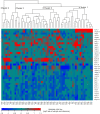Genomic analyses of germline and somatic variation in high-grade serous ovarian cancer
- PMID: 37460928
- PMCID: PMC10351177
- DOI: 10.1186/s13048-023-01234-x
Genomic analyses of germline and somatic variation in high-grade serous ovarian cancer
Abstract
Background: High-grade serous ovarian cancers (HGSCs) display a high degree of complex genetic alterations. In this study, we identified germline and somatic genetic alterations in HGSC and their association with relapse-free and overall survival. Using a targeted capture of 557 genes involved in DNA damage response and PI3K/AKT/mTOR pathways, we conducted next-generation sequencing of DNA from matched blood and tumor tissue from 71 HGSC participants. In addition, we performed the OncoScan assay on tumor DNA from 61 participants to examine somatic copy number alterations (SCNA).
Results: Approximately one-third of tumors had loss-of-function (LOF) germline (18/71, 25.4%) or somatic (7/71, 9.9%) variants in the DNA homologous recombination repair pathway genes BRCA1, BRCA2, CHEK2, MRE11A, BLM, and PALB2. LOF germline variants also were identified in other Fanconi anemia genes and in MAPK and PI3K/AKT/mTOR pathway genes. Most tumors harbored somatic TP53 variants (65/71, 91.5%). Using the OncoScan assay on tumor DNA from 61 participants, we identified focal homozygous deletions in BRCA1, BRCA2, MAP2K4, PTEN, RB1, SLX4, STK11, CREBBP, and NF1. In total, 38% (27/71) of HGSC patients harbored pathogenic variants in DNA homologous recombination repair genes. For patients with multiple tissues from the primary debulking or from multiple surgeries, the somatic mutations were maintained with few newly acquired point mutations suggesting that tumor evolution was not through somatic mutations. There was a significant association of LOF variants in homologous recombination repair pathway genes and high-amplitude somatic copy number alterations. Using GISTIC analysis, we identified NOTCH3, ZNF536, and PIK3R2 in these regions that were significantly associated with an increase in cancer recurrence and a reduction in overall survival.
Conclusions: From 71 patients with HGCS, we performed targeted germline and tumor sequencing and provided a comprehensive analysis of these 557 genes. We identified germline and somatic genetic alterations including somatic copy number alterations and analyzed their associations with relapse-free and overall survival. This single-site long-term follow-up study provides additional information on genetic alterations related to occurrence and outcome of HGSC. Our findings suggest that targeted treatments based on both variant and SCNA profile potentially could improve relapse-free and overall survival.
Keywords: Germline mutations; High-grade serous ovarian cancer; Homologous recombination repair; Somatic mutations; Somatic copy number alterations.
© 2023. The Author(s).
Conflict of interest statement
Both Drs. Wakabayashi and Cristea now work at Regeneron; they worked at City of Hope when the data were generated. Dr. Han receives research funding from Vergent Biosciences. None of the other authors report conflicts of interest.
Figures






Update of
-
Genomic Analyses of Germline and Somatic Variation in High-Grade Serous Ovarian Cancer.Res Sq [Preprint]. 2023 Feb 20:rs.3.rs-2592107. doi: 10.21203/rs.3.rs-2592107/v1. Res Sq. 2023. Update in: J Ovarian Res. 2023 Jul 17;16(1):141. doi: 10.1186/s13048-023-01234-x. PMID: 36865331 Free PMC article. Updated. Preprint.
Similar articles
-
Genomic Analyses of Germline and Somatic Variation in High-Grade Serous Ovarian Cancer.Res Sq [Preprint]. 2023 Feb 20:rs.3.rs-2592107. doi: 10.21203/rs.3.rs-2592107/v1. Res Sq. 2023. Update in: J Ovarian Res. 2023 Jul 17;16(1):141. doi: 10.1186/s13048-023-01234-x. PMID: 36865331 Free PMC article. Updated. Preprint.
-
Germline and somatic variants in ovarian carcinoma: A next-generation sequencing (NGS) analysis.Front Oncol. 2022 Dec 1;12:1030786. doi: 10.3389/fonc.2022.1030786. eCollection 2022. Front Oncol. 2022. PMID: 36531003 Free PMC article.
-
Germline and somatic mutations of multi-gene panel in Chinese patients with epithelial ovarian cancer: a prospective cohort study.J Ovarian Res. 2019 Aug 31;12(1):80. doi: 10.1186/s13048-019-0560-y. J Ovarian Res. 2019. PMID: 31472684 Free PMC article.
-
Targeting DNA repair: the genome as a potential biomarker.J Pathol. 2018 Apr;244(5):586-597. doi: 10.1002/path.5025. Epub 2018 Feb 10. J Pathol. 2018. PMID: 29282716 Review.
-
[Oncopathological aspects of BRCA1 and BRCA2 genes inactivation in tumors of ovary, fallopian tube and pelvic peritoneum].Cesk Patol. 2016 Fall;52(4):199-204. Cesk Patol. 2016. PMID: 27869446 Review. Czech.
Cited by
-
Characterization of zinc finger protein 536, a neuroendocrine regulator, using pan-cancer analysis.Eur J Med Res. 2024 May 8;29(1):273. doi: 10.1186/s40001-024-01792-w. Eur J Med Res. 2024. PMID: 38720348 Free PMC article.
-
Serine/threonine kinase 11 (STK11) associated adnexal tumors: from biology to therapeutic impact.Hum Genomics. 2025 Mar 18;19(1):28. doi: 10.1186/s40246-025-00741-w. Hum Genomics. 2025. PMID: 40102938 Free PMC article. Review.
-
Amplified Cell Cycle Genes Identified in High-Grade Serous Ovarian Cancer.Cancers (Basel). 2024 Aug 7;16(16):2783. doi: 10.3390/cancers16162783. Cancers (Basel). 2024. PMID: 39199556 Free PMC article.
-
In silico analysis of several frequent SLX4 mutations appearing in human cancers.MicroPubl Biol. 2024 May 17;2024:10.17912/micropub.biology.001216. doi: 10.17912/micropub.biology.001216. eCollection 2024. MicroPubl Biol. 2024. PMID: 38828439 Free PMC article.
-
Research progress on m6A and drug resistance in gastrointestinal tumors.Front Pharmacol. 2025 Apr 28;16:1565738. doi: 10.3389/fphar.2025.1565738. eCollection 2025. Front Pharmacol. 2025. PMID: 40356985 Free PMC article. Review.
References
-
- Laine A, Sims TT, Le Saux O, Ray-Coquard I, Coleman RL. Treatment Perspectives for Ovarian Cancer in Europe and the United States: Initial Therapy and Platinum-Sensitive Recurrence after PARP Inhibitors or Bevacizumab Therapy. Curr Oncol Rep. 2021;23(12):148. doi: 10.1007/s11912-021-01128-5. - DOI - PubMed
MeSH terms
Substances
Grants and funding
LinkOut - more resources
Full Text Sources
Medical
Research Materials
Miscellaneous

